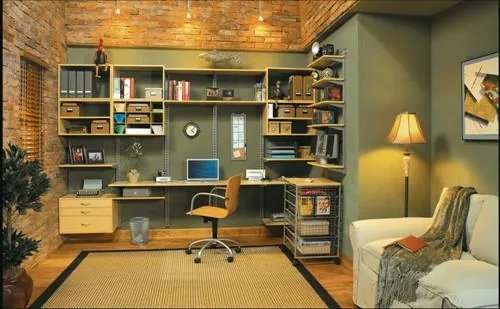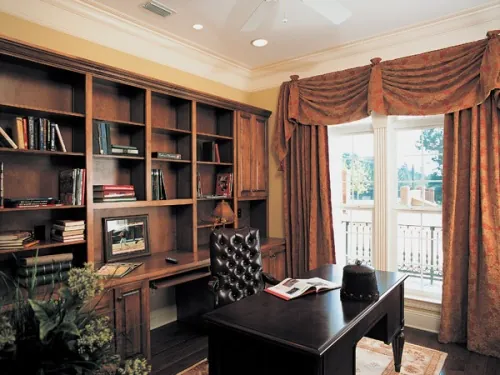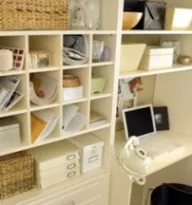 by Leslie Patterson
by Leslie Patterson
It used to be that working from home was only for courageous entrepreneurs.
 |
Photo courtesy of SCHULTE Storage |
Most often these were small, home-based businesses that were born out of hobbies, not necessarily meant to compete with larger corporations. As technology has improved, the nature of the home office has certainly changed – what was once a luxury afforded to few has become the mainstream way to work in companies large and small.
This trend in working from home is certainly appealing at first glance: more family time, no commute through rush hours, perhaps one could even sleep a bit longer! However, few people are prepared for the challenges that come along with working from home: seemingly constant family time and the easily blurred boundaries of personal and business life. The importance of a designated home office space quickly becomes evident. By following a few steps, a home office design balancing efficiency and personal aesthetics can easily be achieved.

View this House Plan
View Other Luxury House Plans
Before tossing all the office supplies in the middle of the floor and going to work, take the time to realistically evaluate your home office needs:
Privacy Requirements
Will you be meeting with clients? Do you need to keep an eye on the kids during your work time? How distracting are other elements of your home life?
Work Style
Is your work mostly electronic/computer based? Will you handle excessive paperwork? What will special projects require in terms of space?
Supplies
What are your must-have office supplies? What
storage woes are you facing?
Upon answering these questions many homeowners are able to resolve home office problems before they arise. While every situation is certainly different, there are some solutions to common issues that you should keep in mind.
Firstly, determine what space is the best fit for your home office. Many homeowners will require an entire spare room; others need a somewhat secluded corner of another room. It is not impossible to make the home "office" multifunctional, as long as you determine which areas are for work and play. Whether a designated room or set-aside niche, the space should be at least 10 feet by 10 feet.
After determining where your office will be located, it is a good idea to break the space down:
Computer Zone
It is important to have a space where computer work can be done without the keyboard and mouse competing for space with other work essentials. For the most comfortable and healthy computer use, place the monitor at eye level approximately 18-28 inches away from your seated position.
Paperwork
Every job requires a certain amount of paperwork, and this is the place to handle mail and other documents. A minimum five feet of surface workspace is required to keep this area efficient. A portion of this surface can be dedicated to filing systems and necessary supplies, but the rest should be clutter free to focus on the task at hand. Keep this area adjacent to your computer zone for easy transition between work spaces.
Surrounding Space
Though the desk is typically the main focus in a home office, it is important to give the surrounding space proper attention. A cozy chair, window seat, and small table provides supplementary seating for clients, as well as a small change of scenery when working from the desk feels monotonous.
Storage
While these are not necessary to keep within arms reach, it is a good idea to focus on quality storage around the room. You have to see what is in your office on a daily basis so resist plastic bins and cheap shelving. With the massive movement to home office design, more retailers carry attractive budget-friendly storage accessories like faux leather file boxes, streamlined cabinets, and inexpensive do-it-yourself shelving units.
Projects and Large Tasks
If your job requires work on projects and other tasks that will easily overwhelm your desk, it is important to have a spot for these to reside. The designated space for large projects also allows suitable supplies to be stored near the project, increasing functionality of the room.
 |
Photo courtesy of ClosetMaid |
Once the office is broken into efficient workstations, it is time to look at the room's aesthetics. One of the best aspects of working from home is the personal touch you can give your work environment. It is important to acknowledge that you are free to think outside the corporate box. This is your home office and you are not limited to any specific arrangement or decor within budget. There are some details that will greatly improve your work if given proper attention:
Desk Position
Feng shui practices recommend placing the desk facing the
door to see who enters the room. This is a power position that lends itself to efficiency and prevents sore necks from repeated twisting toward the door.
Lighting
It is important to avoid glare and eyestrain so a good balance of recessed, task, and natural lighting should be considered for the office. Seek a professional's opinion before undertaking any electrical projects.
Color
Embrace the use of
color in your home office. Dull and cool colors promote lethargy, so turn instead to rich reds, blues, and purples that represent prosperity. Greens are soothing so incorporate a few live plants to improve the room's well being.
Boundaries
It is vital to productivity and sanity to keep your personal and business lives separate. Make a daily schedule and stick to it, even if you think sleeping an extra hour cannot hurt because the office is just down the hall. Often times that extra hour of sleep turns into an extra hour of work, cutting into family dinners or special events. Or it may simply mean an hour loss of productivity that can be damaging down the line. In either case, using your time wisely is key to balancing your work life and your home life.
Noise Buffers
Though the house may not be your responsibility during your work hours, the smallest noises will distract you from tasks at hand. Use doors and carpeting to mask the hum of laundry machines or the children's television show. Try to avoid giving into temptations of "quick breaks" for snacking in the
kitchen or checking the news on TV. This loss in concentration wastes more time than the break itself.
Clutter
Noise clutter and physical clutter create distractions and increase stress levels. Evaluate the office weekly and remove unnecessary objects like wayward toys and trinkets. File completed paperwork immediately so is does not inhibit your ability to find what you need quickly. Clutter also applies to your computer. Organize file folders and keep the desktop clear to make it easier to locate documents in a flash. Organize important emails and rid your inbox of unnecessary correspondence.
Remember that your home office is a reflection of you and the work you produce. Make it a priority to keep the space efficient and eye appealing and you will find your job easier day to day. Take the time to evaluate the space regularly and make changes to what no longer works. Keep this room working for you and the commute down the hall will be more pleasant than ever imagined.
Here are some related articles:
Save this article to:
back to top